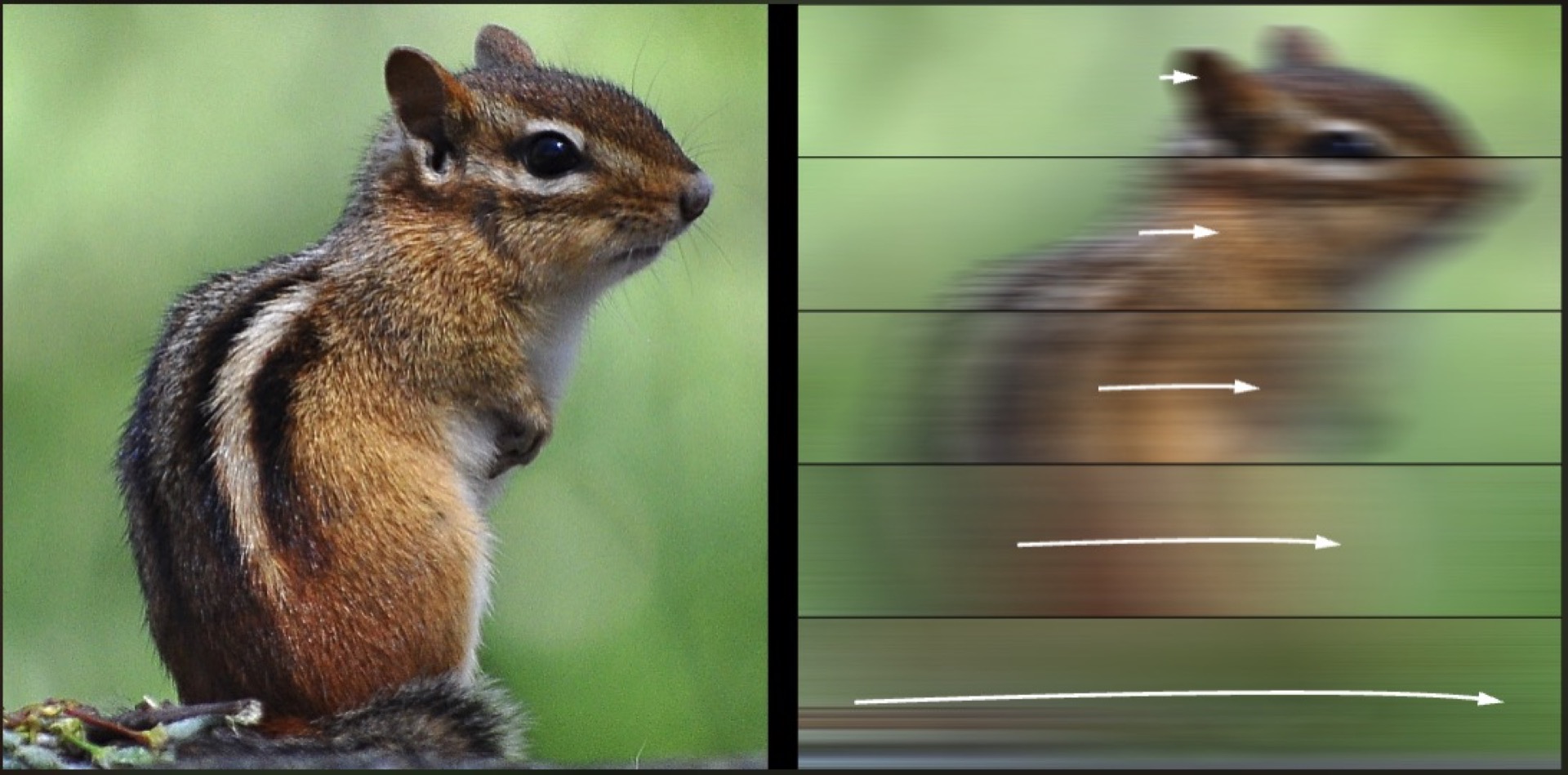Too fast to see: Eye movements predict speed limits in perception
*GERMAN VERSION BELOW*
If you quickly move a camera from object to object, the abrupt shift between the two points causes a motion smear that might give you nausea. Our eyes, however, do movements like these two or three times per second. These rapid movements are called saccades, and although the visual stimulus during a saccade shifts abruptly across the retina, our brain seems to keep it under the hood: we never perceive the shift. New research shows that the speed of our saccades predicts the speed limit in our vision when an object becomes too fast to see. According to a study published in Nature Communications by researchers from the Cluster of Excellence Science of Intelligence (TU Berlin), visual stimuli ––think a chipmunk darting around or a tennis ball hit with full force–– become invisible when they move at a speed, duration, and distance similar to those of one of our saccades. This suggests that the properties of the human visual system are best understood in the context of the movements of our eyes.
When does a moving stimulus become too fast to see?
The limits of how fast an object can be before it becomes invisible to us is directly related to the speed of our own eye movements. Beyond a certain speed, a moving stimulus becomes too fast for us to see. As a result, the speed of our eye movements across a specific distance can be used to predict at what speed a moving stimulus becomes invisible to us. And since the speed of our eye movements changes from person to person, people who make particularly rapid eye movements can also see objects moving at higher speeds than people with slower eye movements. This might mean that the best baseball batters, action video game players, or wildlife photographers are the ones with quicker eye movements.
Our movements shape our perception
This result is exciting as it provides first evidence of the idea that our body movements fundamentally shape the abilities of our perceptual system. “What parts of the physical world we can sense depends fundamentally on how good our sensors are,” explains Martin Rolfs, the lead author of the study. “For example, we don’t see infrared light because our eyes are not sensitive to it, and we fail to see flicker on our screens because they flicker at higher frequencies than our eyes can resolve. In this paper, however, we show that the limits of seeing are not just defined by these biophysical constraints but also by the actions and movements that impose changes on the sensory system. To show this, we used the body’s fastest and most frequent motions, i.e. the saccadic eye movements that people make more than a hundred thousand times a day.”
A motion we don’t perceive
Much like a camera movement causes motion in a movie, saccades create movement patterns on the retina. “But we never consciously perceive that motion,” says Rolfs. “We have shown that stimuli that follow the same (very specific) movement patterns as saccades (while people are holding their eyes still) also become invisible. So we are basically suggesting that the kinematics of our actions (here, saccades) fundamentally constrain a sensory system’s access to the physical world around us.” Rolfs explained that this is to be considered an intelligent trait of the visual system, because it remains sensitive to fast motion, but only up to speeds that result specifically from saccades, and these speeds are not seen consciously albeit available to the brain. “In simple terms,the properties of a sensory system such as the human visual system are best understood in the context of the kinematics of actions that drive its input(in this case, rapid eye movements),” said Rolfs.
A finely tuned machine
“Our visual system and motor system are finely tuned to each other, but this has long been ignored,” says Martin Rolfs. “One of the issues is that the people who study motor control are not the same ones who study perception. They attend different conferences, they publish in different journals –– but they should be talking!”
This study suggests that our visual system can recognize when a stimulus moves in a way that is similar to our own eye movements, and then filters out the conscious perception of this movement. This also introduces a new mechanism to explain why we do not see visual motion smear on the retina during eye movements as we would if we were using a camera.
In brief:
- Objects moving at speeds, durations, and distances similar to those of our saccades can become invisible to us—even when our eyes are still.
- People with faster saccadic eye movements can perceive faster-moving objects better than those with slower ones.
- The ability to perceive motion is not just about sensory limits but also shaped by the movements that drive sensory input.
- Our visual and motor systems are tightly coordinated, yet often studied separately—to understand perception, we need to understand action.—————
Zu schnell zum Sehen: Augenbewegungen sagen Geschwindigkeitsgrenzen in der Wahrnehmung voraus
Wenn man eine Kamera schnell von einem Objekt zu einem anderen bewegt, verursacht die abrupte Verschiebung zwischen den beiden Punkten eine Bewegungsunschärfe, die sogar Übelkeit bereiten kann. Unsere Augen führen solche Bewegungen jedoch zwei- oder dreimal pro Sekunde aus. Diese schnellen Bewegungen werden Sakkaden genannt, und obwohl sich der visuelle Reiz während einer Sakkade abrupt über die Netzhaut verschiebt, scheint unser Gehirn dies unter der Haube zu halten: Wir nehmen die Verschiebung nicht wahr. Neue Forschungsergebnisse zeigen, dass die Geschwindigkeit unserer Sakkaden die Geschwindigkeitsgrenze in unserem Sehvermögen vorhersagt, wenn ein Objekt zu schnell wird, um es zu sehen. Laut einer in Nature Communications veröffentlichten Studie von Forschern des Exzellenzclusters Science of Intelligence (TU Berlin) werden visuelle Reize – z. B. ein herumflitzendes Streifenhörnchen oder ein mit voller Wucht getroffener Tennisball – unsichtbar, wenn sie sich mit einer Geschwindigkeit, Dauer und Entfernung bewegen, die denen einer unserer Sakkaden entsprechen. Dies deutet darauf hin, dass die Eigenschaften des menschlichen Sehsystems am besten im Zusammenhang mit den Bewegungen unserer Augen zu verstehen sind.
Wann wird ein sich bewegender Stimulus zu schnell, um gesehen zu werden?
Die Grenzen, wie schnell ein Objekt sein kann, bevor es für uns unsichtbar wird, hängen direkt mit der Geschwindigkeit unserer eigenen Augenbewegungen zusammen. Ab einer bestimmten Geschwindigkeit wird ein sich bewegender Reiz für uns zu schnell, um ihn zu sehen. Daher kann die Geschwindigkeit unserer Augenbewegungen über eine bestimmte Entfernung genutzt werden, um vorherzusagen, bei welcher Geschwindigkeit ein sich bewegender Reiz für uns unsichtbar wird. Und da die Geschwindigkeit unserer Augenbewegungen von Person zu Person unterschiedlich ist, können Menschen, die besonders schnelle Augenbewegungen machen, auch Objekte sehen, die sich mit höherer Geschwindigkeit bewegen als Menschen mit langsameren Augenbewegungen. Das könnte bedeuten, dass die besten Baseballspieler, Action-Videospieler oder Tierfotografen diejenigen sind, die schnellere Augenbewegungen haben.
Unsere Bewegungen prägen unsere Wahrnehmung
Dieses Ergebnis ist spannend, denn es liefert erste Belege für die Idee, dass unsere Körperbewegungen die Fähigkeiten unseres Wahrnehmungssystems grundlegend beeinflussen. „Welche Teile der physikalischen Welt wir wahrnehmen können, hängt im Wesentlichen davon ab, wie gut unsere Sensoren sind“, erklärt Martin Rolfs, der Hauptautor der Studie. „Wir sehen zum Beispiel kein Infrarotlicht, weil unsere Augen dafür nicht empfindlich sind, und wir sehen kein Flimmern auf unseren Bildschirmen, weil sie mit höheren Frequenzen flimmern, als unsere Augen auflösen können. In dieser Arbeit zeigen wir jedoch, dass die Grenzen des Sehens nicht nur durch diese biophysikalischen Einschränkungen definiert werden, sondern auch durch die Handlungen und Bewegungen, die sich direkt auf das sensorische System auswirken. Um dies zu zeigen, haben wir die schnellsten und häufigsten Bewegungen des Körpers verwendet—die sakkadischen Augenbewegungen, die Menschen mehr als hunderttausend Mal pro Tag ausführen.“
Eine Bewegung, die wir nicht wahrnehmen
Ähnlich wie eine Kamerabewegung in einem Film, erzeugen Sakkaden Bewegungsmuster auf der Netzhaut. „Aber wir nehmen diese Bewegung nie bewusst wahr“, sagt Rolfs. „Wir haben gezeigt, dass Reize, die denselben (sehr spezifischen) Bewegungsmustern wie Sakkaden folgen (während Menschen ihren Blick still an einem Ort halten), ebenfalls unsichtbar werden. Das deutet darauf hin, dass die Kinematik unserer Handlungen (hier Sakkaden) den Zugang eines sensorischen Systems zur physischen Welt um uns herum grundlegend einschränkt.“ Rolfs erläuterte, dass dies als intelligente Eigenschaft des visuellen Systems zu betrachten ist, da es zwar für schnelle Bewegungen empfindlich bleibt, aber nur bis zu Geschwindigkeiten, die sich speziell aus Sakkaden ergeben, und diese Geschwindigkeiten werden nicht bewusst wahrgenommen, obwohl sie dem Gehirn zur Verfügung stehen. „Vereinfacht ausgedrückt, lassen sich die Eigenschaften eines sensorischen Systems wie des menschlichen Sehsystems am besten im Zusammenhang mit der Kinematik der Handlungen verstehen, die seinen Input (in diesem Fall schnelle Augenbewegungen) steuern“, so Rolfs.
Eine fein abgestimmte Maschine
„Unser visuelles und motorisches System sind fein aufeinander abgestimmt, aber das wurde lange Zeit ignoriert“, sagt Martin Rolfs. „Eines der Probleme ist, dass die Leute, die sich mit motorischer Kontrolle beschäftigen, nicht dieselben sind, die sich mit Wahrnehmung beschäftigen. Sie nehmen an verschiedenen Konferenzen teil, veröffentlichen in verschiedenen Zeitschriften – aber sie sollten miteinander reden!“
Diese Studie legt nahe, dass unser visuelles System erkennen kann, wenn sich ein Reiz auf eine Weise bewegt, die unseren eigenen Augenbewegungen ähnelt, und dann die bewusste Wahrnehmung dieser Bewegung herausfiltert. Damit wird auch ein neuer Mechanismus eingeführt, der erklärt, warum wir bei Augenbewegungen keinen visuellen Bewegungsschmiereffekt auf der Netzhaut sehen, wie wir es bei der Verwendung einer Kamera tun würden.
Kurz gefasst:
- Objekte, die sich mit einer ähnlichen Geschwindigkeit, Dauer und Entfernung wie unsere Sakkaden bewegen, können für uns unsichtbar werden – selbst wenn unsere Augen stillstehen.
- Menschen mit schnelleren sakkadischen Augenbewegungen können sich schneller bewegende Objekte besser wahrnehmen als Menschen mit langsameren Bewegungen.
- Die Fähigkeit, Bewegungen wahrzunehmen, hängt nicht nur von den sensorischen Grenzen ab, sondern auch von den Bewegungen, die den sensorischen Input steuern.
- Unser visuelles und unser motorisches System sind eng aufeinander abgestimmt, werden aber oft getrennt voneinander untersucht – um die Wahrnehmung zu verstehen, müssen wir auch die Handlung verstehen.
Photo: Eastern Chipmunk in Erindale Park, Ontario, Canada, Wikimedia, CC BY Oleksii Voronin, right side of image adapted.





